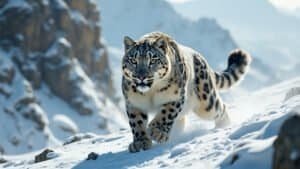Introduction
Snow leopards are among the most elusive and well-adapted predators in the world, thriving in some of the most challenging environments on Earth. In this article, we’ll explore how these magnificent creatures navigate the rugged, mountainous terrain they call home
We’ll delve into the specific physical adaptations that allow them to maintain balance on steep slopes, their instinctual abilities to find paths, and the challenges they face as they move through their high-altitude habitats. Finally, we’ll consider how climate change impacts their ability to navigate and survive in these harsh conditions
Snow Leopards’ Adaptations for Mountain Navigation
Snow leopards are marvelously equipped to survive and thrive in the harsh, mountainous terrains of Central and South Asia. Their ability to navigate these rugged landscapes is a result of a series of specialized adaptations that have evolved over thousands of years
These adaptations include unique physical traits that help them maintain balance, the critical role of their long, bushy tail, and the structure of their paws, which provide stability and grip on rocky surfaces. Together, these features make snow leopards one of the most capable climbers among big cats, perfectly suited for life in their high-altitude homes
Snow Leopards’ Physical Traits for Balance
The physical build of a snow leopard is finely tuned for balance, an essential requirement for survival in mountainous regions. One of the key adaptations is their short forelimbs and longer hind limbs, which give them the power to leap across wide gaps and onto high ledges
Studies have shown that snow leopards can jump distances of up to 50 feet in a single leap, which is critical for moving between the rocky outcrops and cliffs that dominate their habitat (Jackson et al., 2010)
Their muscular build, with powerful shoulder and neck muscles, supports not only their incredible jumping ability but also their prowess in climbing. These features allow them to ascend steep cliffs with relative ease, helping them to avoid predators and hunt for prey in difficult-to-reach locations
The snow leopard’s overall body structure is compact, reducing the risk of injury when navigating through narrow and unstable terrain
Role of the Tail in Navigating Steep Slopes
One of the most distinctive features of the snow leopard is its exceptionally long, thick tail, which can reach up to 40 inches in length—almost as long as its body
This tail serves multiple purposes, but its most critical function is aiding in balance as the animal navigates the precarious, steep slopes of its environment. The tail acts like a counterbalance when the leopard is making sharp turns or walking along narrow ledges. It is particularly useful when the leopard needs to adjust its balance quickly to avoid a fall
Moreover, the tail helps in maintaining stability during leaps and bounds. When a snow leopard jumps from one rocky ledge to another, the tail swings in the opposite direction of the jump, helping to control the leopard’s rotation and ensuring that it lands securely on its target
The tail is also used as a rudder when descending steep slopes, providing additional control over its movements. This balance mechanism is vital for the snow leopard’s ability to stalk prey and move stealthily in its rugged, mountainous habitat
How Snow Leopards’ Paws Provide Grip on Rocky Surfaces
Another crucial adaptation of snow leopards is found in their paws, which are uniquely designed to handle the harsh, uneven surfaces of mountainous terrain
Snow leopards have large, wide paws that act like natural snowshoes, distributing their weight evenly and allowing them to walk on snow without sinking too deeply. This adaptation is vital during the winter months when much of their habitat is covered in snow and ice
The soles of their paws are covered in thick fur, which provides insulation against the cold and adds an extra layer of grip on slippery surfaces. This fur also helps to reduce noise, allowing the snow leopard to move silently while stalking prey. Additionally, their paws have tough, flexible pads that conform to the shape of the rocky surfaces they walk on, giving them excellent traction even on steep, jagged cliffs
Their sharp, retractable claws further enhance their grip, allowing them to dig into the rock or ice and hold onto precarious surfaces. This is particularly important when they are scaling steep inclines or making rapid, agile movements during a hunt
The combination of wide paws, fur-covered soles, and retractable claws makes snow leopards incredibly sure-footed, capable of navigating some of the most treacherous terrains in the animal kingdom
Finding Paths in the Rugged Mountain Terrain
Navigating the mountainous terrain is no small feat, but snow leopards are well-equipped with a combination of physical prowess and instinctual behavior that allows them to find and traverse the most complex landscapes
Their environment, characterized by steep cliffs, deep gorges, and rugged terrain, demands not only strength and balance but also a keen sense of direction and familiarity with their surroundings. Snow leopards use a variety of techniques to find paths, whether they are hunting for prey or simply moving through their vast territories
Snow Leopards’ Natural Instincts in Pathfinding
One of the most remarkable aspects of snow leopards is their natural ability to navigate through some of the world’s most challenging landscapes. They are highly territorial animals, and within their large home ranges, they develop a deep familiarity with the terrain
This familiarity is crucial for their survival, as it allows them to avoid dangers and maximize their hunting efficiency. Snow leopards often use the same paths repeatedly, creating a network of trails that they follow as they patrol their territory. These paths are usually located along ridgelines and the edges of cliffs, where they can maintain a high vantage point to survey their surroundings
Studies have shown that snow leopards possess a strong spatial memory, enabling them to remember the locations of key features in their environment, such as hunting grounds, dens, and escape routes (McCarthy et al., 2005)
This memory is essential for their ability to navigate the complex and often treacherous terrain. Additionally, their keen sense of smell and sight helps them detect changes in their environment, such as the presence of other predators or potential prey, further guiding their movements through the mountains
Importance of Terrain Familiarity for Snow Leopards
Familiarity with their environment is one of the snow leopard’s greatest assets in navigating mountainous terrain. Young snow leopards learn the layout of their territory from their mothers, following them closely during their early years
This learning process involves not only identifying the safest and most efficient routes but also understanding the seasonal changes that can alter the landscape. For example, snow leopards may avoid certain areas during the winter when heavy snow can make them more dangerous or inaccessible
As solitary animals, snow leopards must rely on their knowledge of the terrain to avoid conflicts with other leopards or predators, as well as to find the best locations for hunting and resting
This understanding of the terrain is particularly important when hunting, as snow leopards often use the natural features of the landscape to their advantage. They may use rocky outcrops or the curvature of a slope to remain hidden from prey until the last moment, ensuring a successful hunt
Techniques Snow Leopards Use to Traverse Complex Landscapes
Snow leopards employ a range of techniques to traverse the complex landscapes of their mountainous habitats. One of the most notable is their ability to move quietly and with great agility, even on the steepest and most uneven surfaces
This stealthy movement is essential for both hunting and avoiding detection by other predators. They carefully place each paw as they walk, minimizing noise and reducing the chance of dislodging loose rocks or creating a disturbance that could alert prey or rivals
When navigating particularly steep or unstable terrain, snow leopards will often crouch low to the ground, distributing their weight more evenly and increasing their stability. This technique allows them to move more securely across loose rocks or slippery surfaces
Additionally, snow leopards are known to zigzag across steep slopes rather than moving straight up or down, a technique that reduces the strain on their muscles and provides better control over their movements
Their impressive leaping ability is another crucial technique for navigating their environment. Snow leopards can leap vertically and horizontally with remarkable precision, allowing them to move quickly across broken terrain or from one rock ledge to another. This ability is particularly useful when pursuing prey, as it allows them to close the distance rapidly or to ambush from an unexpected angle
In essence, the snow leopard’s navigation techniques are a blend of learned behavior, instinctual actions, and physical adaptations, all of which contribute to their mastery of their mountainous domain
Challenges Snow Leopards Face in Mountain Navigation
Despite their impressive adaptations and skills, snow leopards face numerous challenges as they navigate the rugged mountainous terrain of their natural habitats
These challenges range from environmental obstacles to the impacts of climate change and the constant need to balance predator-prey dynamics. Understanding these challenges provides insight into the resilience of snow leopards and the ongoing threats to their survival
Environmental Obstacles in Mountain Habitats
The harsh environment in which snow leopards live presents constant physical challenges. The high-altitude regions they inhabit are characterized by steep, rocky terrain, deep snow, and extreme weather conditions
In winter, heavy snowfall can cover much of the terrain, making it more difficult for snow leopards to find and follow their usual paths. Snow and ice can also make the terrain more slippery, increasing the risk of falls and injuries. In some areas, avalanches are a significant hazard, capable of altering the landscape and destroying habitats
In addition to natural hazards, snow leopards must also navigate the sparse vegetation and limited cover in their environment. The rocky outcrops and cliffs that dominate their habitat provide limited hiding spots, making it challenging for snow leopards to remain concealed while hunting or avoiding potential threats
Furthermore, the thin air at high altitudes can make physical exertion more taxing, adding to the difficulty of moving through the terrain
Predators and Prey: Navigating with Caution
As apex predators, snow leopards must constantly balance the need to hunt with the need to avoid conflicts with other large predators, such as wolves or even other snow leopards
Although snow leopards are solitary animals and typically avoid direct confrontations, their territorial nature means they must be vigilant when moving through areas that may overlap with the territories of others. This requires not only physical agility but also a keen awareness of their surroundings and the behaviors of other animals in the area
When hunting, snow leopards must carefully navigate the terrain to position themselves for a successful ambush. Their prey, which includes animals such as blue sheep (bharal) and ibex, are also well-adapted to the mountainous environment, making them difficult to catch. Snow leopards often have to cover large distances over difficult terrain to track and approach their prey, requiring both stamina and strategic thinking
The element of surprise is crucial, as a missed opportunity can mean expending significant energy with no reward, which is particularly costly in the energy-scarce environment of the mountains
Impact of Climate Change on Snow Leopard Habitats
Climate change is an emerging threat that poses significant challenges to snow leopards, particularly in terms of their ability to navigate and survive in their mountainous habitats. Rising temperatures are causing glaciers to retreat and snowlines to shift higher, altering the landscape that snow leopards have adapted to over millennia
These changes can reduce the availability of prey species, as herbivores like bharal may move to higher altitudes or different regions in search of suitable grazing areas. This shift can force snow leopards to follow their prey into new, unfamiliar territories, increasing the risks associated with navigation and survival
Additionally, climate change is leading to more frequent and severe weather events, such as intense storms and heavy snowfall, which can disrupt the snow leopard’s ability to hunt and move through its environment. Changes in vegetation patterns due to warming temperatures may also reduce the availability of cover for snow leopards, making it harder for them to ambush prey or avoid detection by humans and other predators
Human activity, exacerbated by climate change, is another significant factor. As human populations expand and encroach on snow leopard habitats, the construction of roads, mining activities, and increased livestock grazing disrupt the natural landscape
These activities not only destroy critical habitats but also create barriers that snow leopards must navigate around, often leading to increased human-wildlife conflict
The combined pressures of environmental challenges, predator-prey dynamics, and the impact of climate change highlight the complex and precarious situation snow leopards face in their natural habitat
Despite their remarkable adaptations, these challenges are significant and underscore the importance of conservation efforts aimed at protecting both snow leopards and the fragile ecosystems they depend on
Conclusion
Snow leopards, with their incredible adaptations, are true masters of the mountainous terrain they inhabit. Their powerful physical traits, including their muscular build, long tail, and specialized paws, enable them to navigate some of the world’s most challenging landscapes with grace and precision
Their natural instincts and familiarity with their environment further aid them in finding paths and successfully hunting in this harsh terrain
However, the challenges they face are significant. From the environmental obstacles of their high-altitude habitats to the threats posed by climate change and human encroachment, snow leopards must constantly adapt to survive
Understanding these challenges highlights the delicate balance these majestic creatures maintain in their struggle for survival and underscores the urgent need for continued conservation efforts













